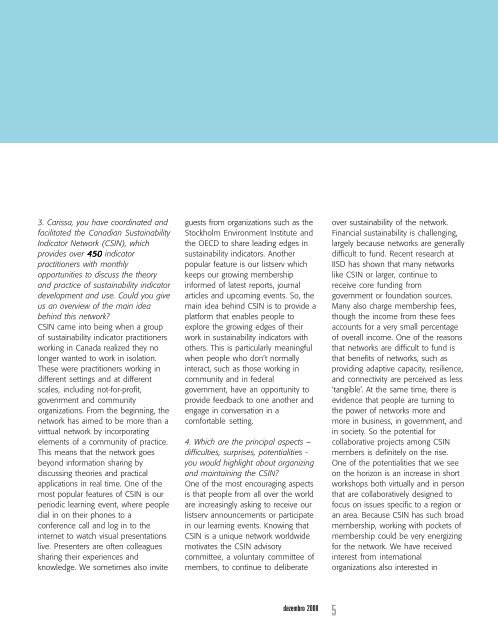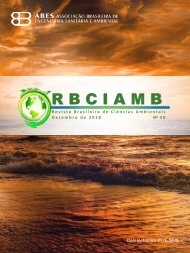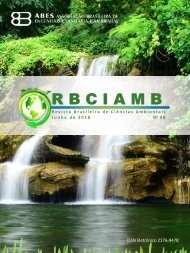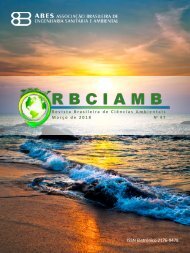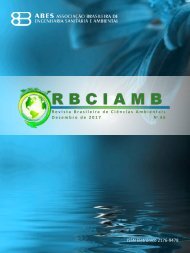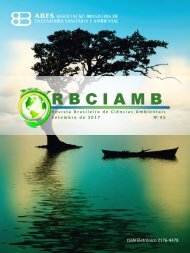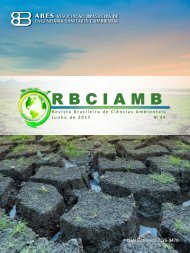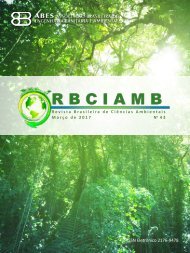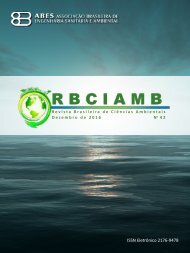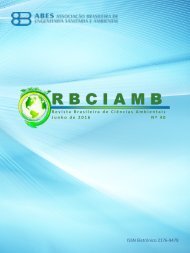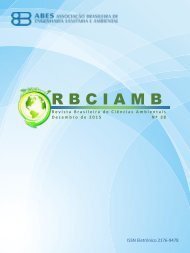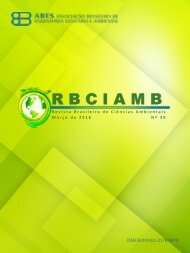EDIÇÃO 11 - Dezembro/08 - RBCIAMB
A Revista Brasileira de Ciências Ambientais – RBCIAMB - publica artigos completos de trabalhos científicos originais ou trabalhos de revisão com relevância para a área de Ciências Ambientais. A RBCIAMB prioriza artigos com perspectiva interdisciplinar. O foco central da revista é a discussão de problemáticas que se inscrevam na relação sociedade e natureza em sentido amplo, envolvendo aspectos ambientais em processos de desenvolvimento, tecnologias e conservação. A submissão dos trabalhos é de fluxo contínuo.
A Revista Brasileira de Ciências Ambientais – RBCIAMB - publica artigos completos de trabalhos científicos originais ou trabalhos de revisão com relevância para a área de Ciências Ambientais. A RBCIAMB prioriza artigos com perspectiva interdisciplinar. O foco central da revista é a discussão de problemáticas que se inscrevam na relação sociedade e natureza em sentido amplo, envolvendo aspectos ambientais em processos de desenvolvimento, tecnologias e conservação. A submissão dos trabalhos é de fluxo contínuo.
You also want an ePaper? Increase the reach of your titles
YUMPU automatically turns print PDFs into web optimized ePapers that Google loves.
3. Carissa, you have coordinated andfacilitated the Canadian SustainabilityIndicator Network (CSIN), whichprovides over 450 indicatorpractitioners with monthlyopportunities to discuss the theoryand practice of sustainability indicatordevelopment and use. Could you giveus an overview of the main ideabehind this network?CSIN came into being when a groupof sustainability indicator practitionersworking in Canada realized they nolonger wanted to work in isolation.These were practitioners working indifferent settings and at differentscales, including not-for-profit,govenrment and communityorganizations. From the beginning, thenetwork has aimed to be more than avirttual network by incorporatingelements of a community of practice.This means that the network goesbeyond information sharing bydiscussing theories and practicalapplications in real time. One of themost popular features of CSIN is ourperiodic learning event, where peopledial in on their phones to aconference call and log in to theinternet to watch visual presentationslive. Presenters are often colleaguessharing their experiences andknowledge. We sometimes also inviteguests from organizations such as theStockholm Environment Institute andthe OECD to share leading edges insustainability indicators. Anotherpopular feature is our listserv whichkeeps our growing membershipinformed of latest reports, journalarticles and upcoming events. So, themain idea behind CSIN is to provide aplatform that enables people toexplore the growing edges of theirwork in sustainability indicators withothers. This is particularly meaningfulwhen people who don’t normallyinteract, such as those working incommunity and in federalgovernment, have an opportunity toprovide feedback to one another andengage in conversation in acomfortable setting.4. Which are the principal aspects –difficulties, surprises, potentialities -you would highlight about organizingand maintaining the CSIN?One of the most encouraging aspectsis that people from all over the worldare increasingly asking to receive ourlistserv announcements or participatein our learning events. Knowing thatCSIN is a unique network worldwidemotivates the CSIN advisorycommittee, a voluntary committee ofmembers, to continue to deliberateover sustainability of the network.Financial sustainability is challenging,largely because networks are generallydifficult to fund. Recent research atIISD has shown that many networkslike CSIN or larger, continue toreceive core funding fromgovernment or foundation sources.Many also charge membership fees,though the income from these feesaccounts for a very small percentageof overall income. One of the reasonsthat networks are difficult to fund isthat benefits of networks, such asproviding adaptive capacity, resilience,and connectivity are perceived as less‘tangible’. At the same time, there isevidence that people are turning tothe power of networks more andmore in business, in government, andin society. So the potential forcollaborative projects among CSINmembers is definitely on the rise.One of the potentialities that we seeon the horizon is an increase in shortworkshops both virtually and in personthat are collaboratively designed tofocus on issues specific to a region oran area. Because CSIN has such broadmembership, working with pockets ofmembership could be very energizingfor the network. We have receivedinterest from internationalorganizations also interested indezembro 20<strong>08</strong>5


